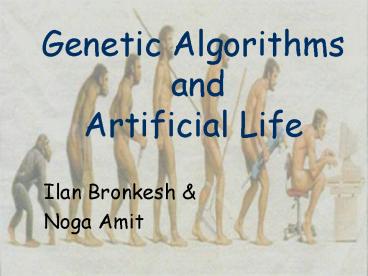Genetic Algorithms and Artificial Life - PowerPoint PPT Presentation
1 / 21
Title:
Genetic Algorithms and Artificial Life
Description:
... encoded in a lookup tables ... 20 generations the trend start to reverse! Effect of dynamic environment ... kind of evolution, more free 'gene duplication' ... – PowerPoint PPT presentation
Number of Views:87
Avg rating:3.0/5.0
Title: Genetic Algorithms and Artificial Life
1
Genetic Algorithms and Artificial Life
- Ilan Bronkesh
- Noga Amit
2
What did we talk about?
- Introduction
- Overview of genetic algorithms
- Interaction between learning and evolution
- Summary
3
Genetic Algorithms
- Evolution by natural selection is a central idea
in biology - Evolution of artificial systems as an important
component of artificial life - 2 function
- Tools of solving practical problems
- Scientific models of evolutionary processes
4
Genetic Algorithms structure
- Representation of the problem
- The fitness function and scaling
- Heredity to the next generation
5
Social systems
- GAs play a major role in understanding and
modeling social systems. - One central field in this research is modeling
the evolution of cooperation. - The subject will be viewed in the context of the
Prisoners Dilemma.
6
The Prisoner Dilemma (PD)
- A simple 2-person game
- Was studied extensively in game theory, economics
political science - Considered to be an idealized model for real
world phenomena such as arm races.
7
The Prisoner Dilemma (cont)
Player B
Player A
- On a given turn, each player independently
decides whether to cooperate or defect
8
The Prisoner Dilemma (cont)
Player B
Player A
- If both players cooperate they each get 3 points
9
The Prisoner Dilemma (cont)
Player B
Player A
- If player A defects player B cooperate player
A gets 5 points and player B gets none, and vice
versa.
10
The Prisoner Dilemma (cont)
Player B
Player A
- If both players defect, they each get 1 point.
11
The Prisoner Dilemma (cont)
- What is the best strategy to take?
- For one turn defect!
- The problem is finding an optimum strategy for an
iterated game - This question takes on special significance when
cooperating defecting correspond actions of
the real world.
12
TIT FOR TAT
- Early work of Axelrod, suggested that the
strategy is simple - TIT FOR TAT cooperate in the first move, after
that always do what the other player did in his
last move. - Axelrod performed experiments to see if a GA
could evolve strategies to play the game
successfully
13
TIT FOR TAT (cont)
- The fitness function the average score of the
player - Strategies were encoded in a lookup tables
- Most of the strategies that evolves were similar
to TIT FOR TAT. - But strikingly, the GA occasionally found
strategies that scored much higher that TIT FOR
TAT
14
TIT FOR TAT (cont)
- Did a GA really evolved better strategies that
human designed ones? - The performance of a strategies depends on the
environment the other strategy which is playing - TIT FOR TAT is generalist, whereas highest score
evolved strategies were specializes to given
environment
15
TIT FOR TAT (cont)
- GA is good at doing what evolution often does
- Developing highly specialized adaptation to
specific environment
16
Effect of dynamic environment
- The experiment allowed strategies to play with
each other. - The environment is changing from generation to
generation due to the evolved strategies - At each generation every strategy plays with all
the other, its fitness is the average score of
all the games
17
Effect of dynamic environment
- Axelrod observed an interesting phenomenon
- The GA initially evolves uncooperative strategies
- After about 10-20 generations the trend start
to reverse!
18
Effect of dynamic environment
- Further experiments by Lindgren includes the
possibility of noise - More open-ended kind of evolution, more free
gene duplication - Interesting evolutionary dynamics, including
periods of relative stasis
19
Effect of dynamic environment
- Other work discover PD strategies with imperfect
information about the past . - Both works making PD a more realistic model of
social political interaction. - Immune system not direct mapping from genotype
to phenotype - But connection simple enough to be studied
analytically
20
Summary
- Strategies are represented as look-up tables
- Fitness function the average score in the
prisoner dilemma game - Heredity by mutations in the look-up tables
21
Open discussion
- Try to think of other implementations of genetic
algorithms - In social systems
- In other fields
(now is the time)

